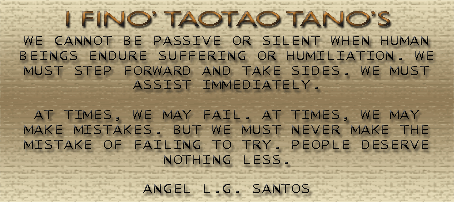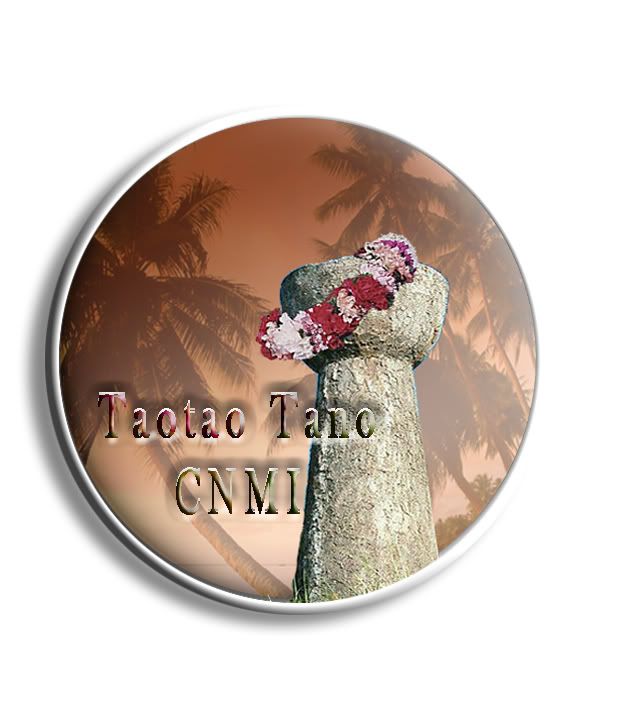Local
Wednesday, January 16, 2008
Taotao Tano sets meeting on NMI federalization bill
The Taotao Tano CNMI Association Inc. is calling for an urgent meeting today with all indigenous Chamorro and Carolinian descents to discuss the pending federal legislation H.R. 3079, which seeks to impose federal control over local immigration. The meeting is at 7pm.
The group, which describes itself as a social advocacy organization, says that H.R. 3079 is an unjust piece of legislation that “will take away our local control of our labor and immigration in our homeland.”
“Our continued silence on this unjust federal legislation will have a negative affect,” said Gregorio Cruz, president of the organization.
“We encourage and humbly ask each of you to attend and join in uniting our island and its local indigenous people under one spirit, one heart and one voice of our true message to our local leaders and the federal government, concerning this critical piece of legislation that will adversely affect us,” he added.
For more information contact Cruz at 256-2325 or Diego at 288-6146. (PR)
UPDATE LINKS ON MISSING PEOPLE
PUBLIC NOTICE!

KAGMAN ZONING COMMUNITY MEETING
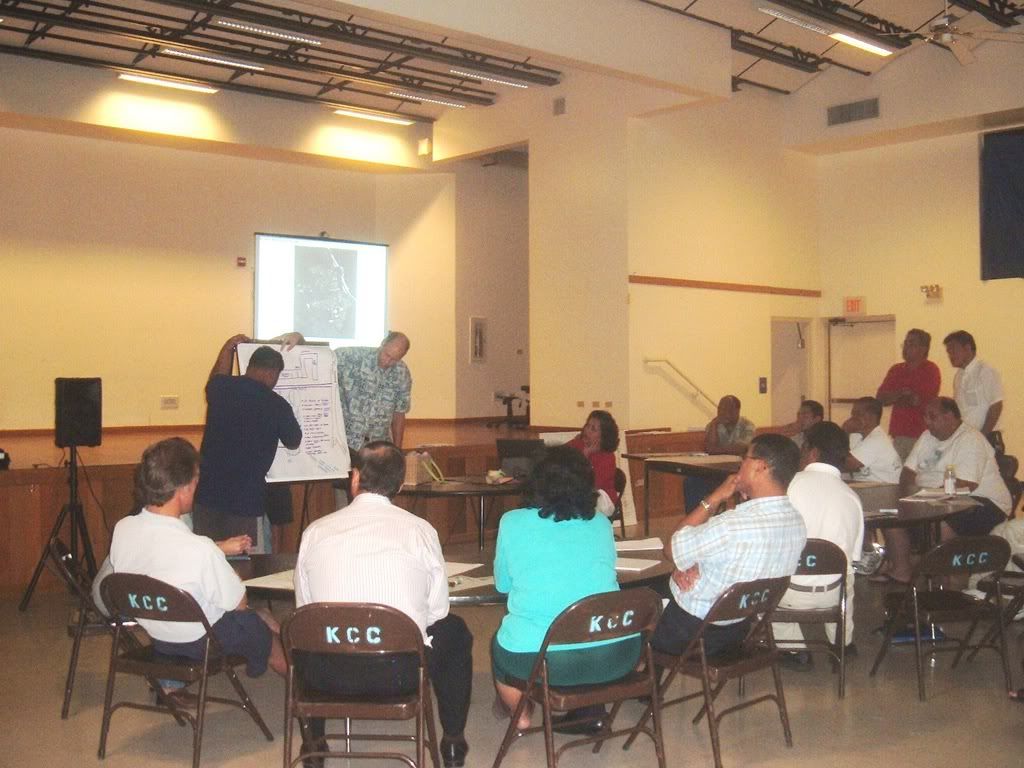 ......................................................................
......................................................................
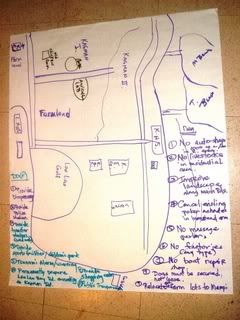
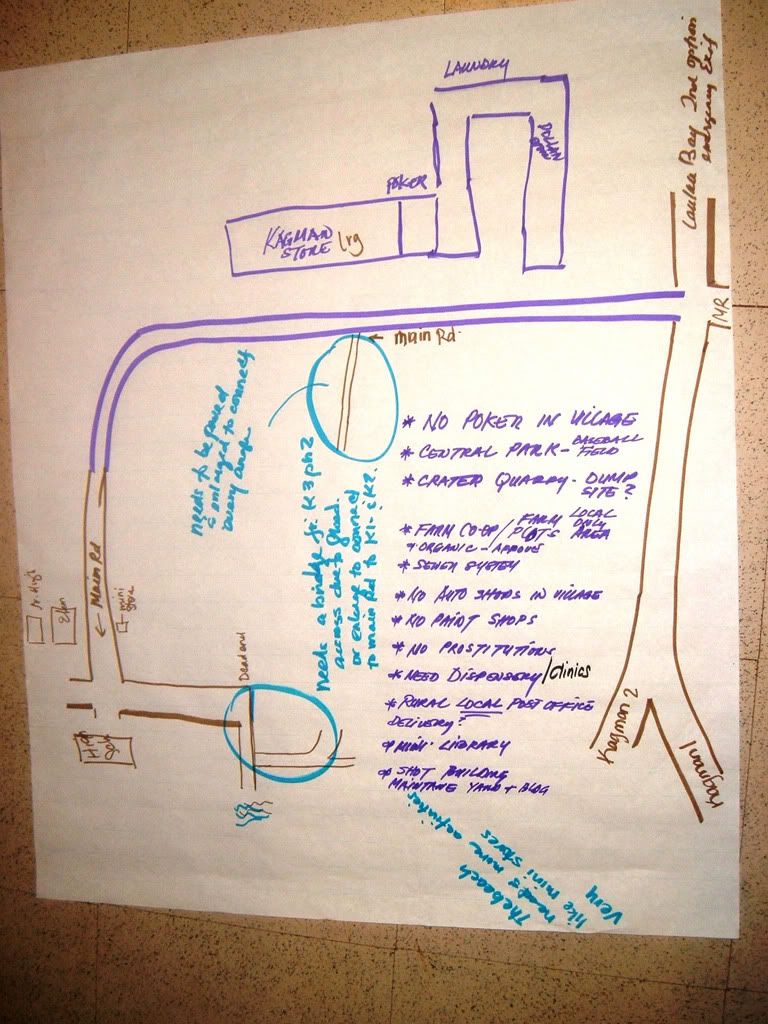
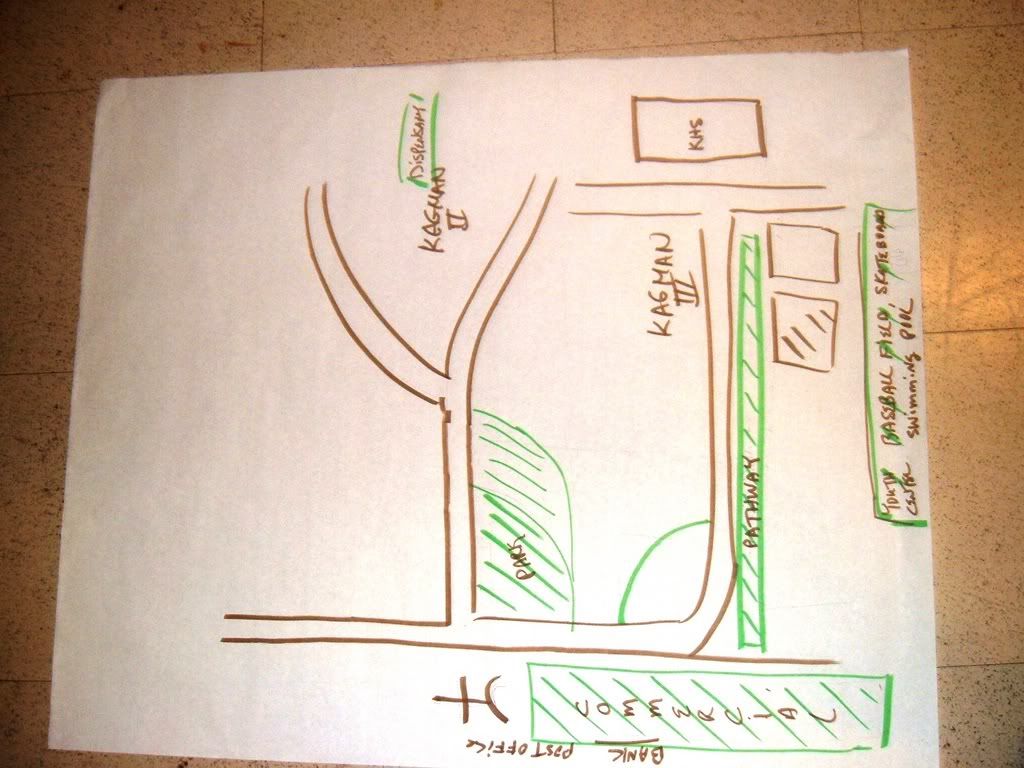
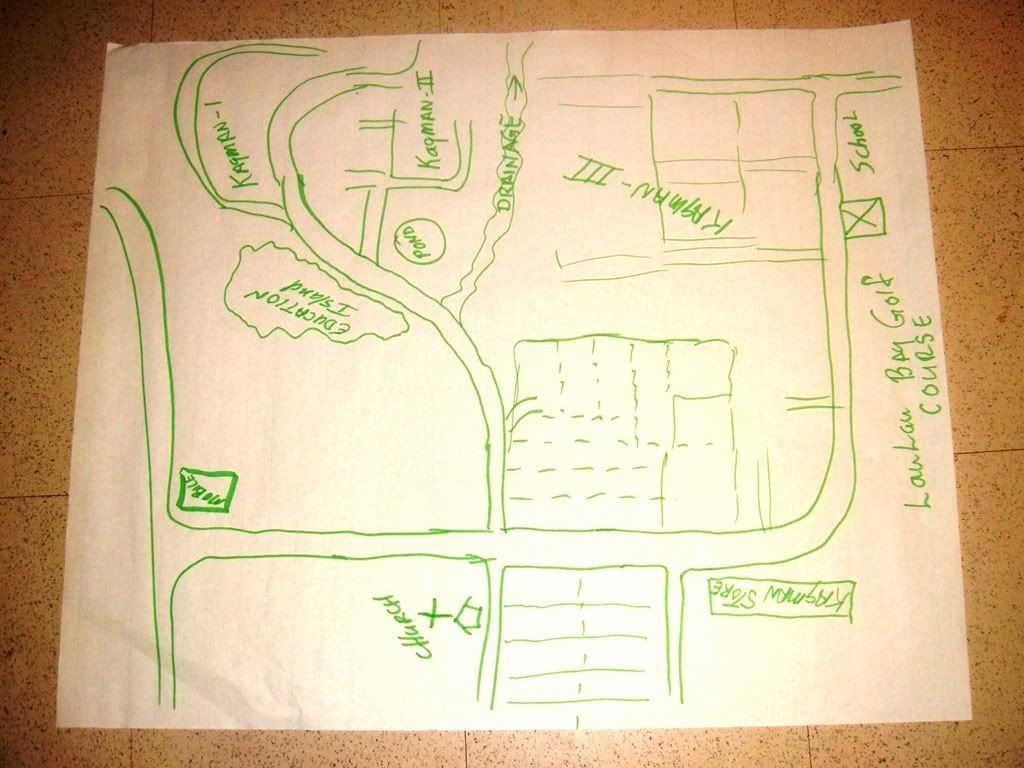 KAGMAN GROUP DRAFT (top left)
TAOTAO TANO grp DRAFT (top right)
3RD GROUP DRAFT (bottom left)
4TH GROUP DRAFT (bottom right)
============================================================
Draft zoning law subdivides Saipan into 13 districts
By Agnes E. Donato
Reporter
The Commonwealth Zoning Board released yesterday for public review a draft zoning law that would subdivide Saipan into 13 zoning districts and guide land development over each of the districts.
The draft law updates the 1993 Saipan Zoning Law to address the current pattern of land use, issues, and government organization.
Some of key benefits expected from the proposed legislation are the improved quality of tourist areas like Garapan and Beach Road, faster processing of zoning permits, and the preservation of “rural” areas on the island.
“We're excited about this draft zoning law because it would enhance our economy and property values, make our roads safer, improve life in our villages and neighborhoods, discourage nuisances and assist careful development. We've been working hard on this draft but now we want to hear from the public so we can make it as good as possible,” said Henry S. Hofschneider, chairman of the Zoning Board.
The Zoning Board will also be providing two major opportunities for public discussion and comment.
There will be an informal daylong open house on Monday, Oct. 15, 2007, from 8:30am to 9pm. It will be held in the Visitor's Center at American Memorial Park. Zoning staff will be available to go over the draft and the map in detail.
The Zoning Board will also hold a formal public hearing on Thursday, Oct. 25, to take oral or written comments. The event will take place at 6:30pm in the Multi-Purpose Center in Susupe.
There will also be a discussion on the draft on the John Gonzales Show on that day.
“We want to make sure people have a chance to learn about the draft and find out how it would affect their future development plans,” Hofschneider said. The Zoning Board has prepared a guide that provides a general introduction to the law.
Under the proposed law, Saipan will have 13 zoning districts: Garapan Core, Garapan East, Beach Road, Industrial, Mixed Commercial, Public Resources, Rural, Village Residential, Village Commercial, Tourist Resort, Agricultural, Adult Business Overlay, and Adult Business Park.
Each zone has a different mix of allowed uses. There are general standards that apply to all uses and special standards that apply to some uses. The proposed zoning district boundaries are shown on the draft Saipan Zoning Map.
The Zoning Board listed the benefits of the draft law as the following:
Economic development
-Improving the quality of tourist areas like Garapan and Beach Road.
-Protecting industrial areas to prevent conflicts with surrounding areas.
-Processing zoning permits faster.
Safety
-Improving safety of new connections to public roads.
-Improving design of new parking lots.
-Restricting new commercial signs in road rights-of-way.
Property Values
-Separating and screening conflicting uses.
-Preventing nonresidential development in villages.
-Preserving the character of rural areas while allowing compatible new development.
-Protecting public resource lands for recreation, tourism, and environmental functions.
-Providing landscaping to screen parking areas and improve commercial areas
-Improving the design of commercial buildings and signs.
Here are specific things the law would do:
-Buildings in Garapan and along Beach Road would have more attractive designs and be pedestrian-friendly. This would implement the recently finalized Garapan and Beach Road Revitalization Plan. All commercial buildings would need to meet basic design standards to make them more attractive and pedestrian-friendly.
-Village residential areas would be limited to single family houses. No new poker, auto body shops or other commercial uses would be allowed there, except home businesses.
-Most of the less-developed land would be zoned “Rural.” Typical uses in the rural zone would be housing, agriculture, public and civic uses, and recreational uses. New hotels, resorts, and certain other businesses could be allowed in the rural area if they meet special requirements.
-Existing major tourist hotels and resorts would be placed in Tourist Resort zoning districts.
-Buildings over 48 feet high would be reviewed to make sure they fit in with the surroundings and that there are adequate roads, utilities, etc.
-There would be two types of commercial districts. The Village Commercial zoning district would allow all office uses, light-duty retail, most public and civic uses as well as a mix of residential uses. The Mixed Commercial zoning district would allow all offices, retail uses, hotels, restaurants, manufacturing and processing (with standards), evening entertainment, and residential uses.
-New gambling machine businesses (poker) would only be permitted in Village Commercial and Mixed Commercial zoning districts on Beach Road between Afetna Rd; and Chalan Msgr. Guerrero; and Chalan Pale Arnold between Chalan Msgr. Guerrero and Industrial Drive and in hotels with more than 20 rooms. New businesses would have to be located at least 100 ft from Laundromats, public primary or secondary schools, parks, playgrounds, churches, and other gambling machine businesses.
-Industrial zoning districts would provide space for heavy industry at Lower Base, the Airport, at operating quarries and the landfill.
-Public Resource zoning districts would be established on public land around Saipan to protect the special values of beaches; parks; and other sites of cultural, historic and scenic value.
-An Agriculture zoning district would be established to protect the prime agricultural land in Kagman.
-Signs would have to be in English, Chamorro, or Carolinian; other languages would be optional as long as there is an exact English translation. The design of signs would be controlled. Commercial signs would not be allowed in the road right-of-way. Certain types of signs such as off-site signs and billboards would be prohibited.
-Landscaping would be required to screen parking lots and commercial buildings from major roads.
-In most cases, existing development that does not comply would be allowed to remain as a “nonconforming use.” Owners could maintain their buildings but not do much expansion. If a nonconforming use closes, it could not be reopened at that location.
People can send comments to the Zoning Board by fax: 670-234-9666, by mail: Zoning Board, Caller Box 10007, Saipan, MP 96950, by e-mail: staff@zoning.gov.mp; or by hand delivery: Zoning Office, 2nd Floor Joeten Building, DanDan.
Zoning Board members are Henry Hofschneider, Chair, Rex Kosack, Vice Chair, Herminia Fusco, Isidoro Cabrera, Liz Rechebei, and David Igitol.
KAGMAN GROUP DRAFT (top left)
TAOTAO TANO grp DRAFT (top right)
3RD GROUP DRAFT (bottom left)
4TH GROUP DRAFT (bottom right)
============================================================
Draft zoning law subdivides Saipan into 13 districts
By Agnes E. Donato
Reporter
The Commonwealth Zoning Board released yesterday for public review a draft zoning law that would subdivide Saipan into 13 zoning districts and guide land development over each of the districts.
The draft law updates the 1993 Saipan Zoning Law to address the current pattern of land use, issues, and government organization.
Some of key benefits expected from the proposed legislation are the improved quality of tourist areas like Garapan and Beach Road, faster processing of zoning permits, and the preservation of “rural” areas on the island.
“We're excited about this draft zoning law because it would enhance our economy and property values, make our roads safer, improve life in our villages and neighborhoods, discourage nuisances and assist careful development. We've been working hard on this draft but now we want to hear from the public so we can make it as good as possible,” said Henry S. Hofschneider, chairman of the Zoning Board.
The Zoning Board will also be providing two major opportunities for public discussion and comment.
There will be an informal daylong open house on Monday, Oct. 15, 2007, from 8:30am to 9pm. It will be held in the Visitor's Center at American Memorial Park. Zoning staff will be available to go over the draft and the map in detail.
The Zoning Board will also hold a formal public hearing on Thursday, Oct. 25, to take oral or written comments. The event will take place at 6:30pm in the Multi-Purpose Center in Susupe.
There will also be a discussion on the draft on the John Gonzales Show on that day.
“We want to make sure people have a chance to learn about the draft and find out how it would affect their future development plans,” Hofschneider said. The Zoning Board has prepared a guide that provides a general introduction to the law.
Under the proposed law, Saipan will have 13 zoning districts: Garapan Core, Garapan East, Beach Road, Industrial, Mixed Commercial, Public Resources, Rural, Village Residential, Village Commercial, Tourist Resort, Agricultural, Adult Business Overlay, and Adult Business Park.
Each zone has a different mix of allowed uses. There are general standards that apply to all uses and special standards that apply to some uses. The proposed zoning district boundaries are shown on the draft Saipan Zoning Map.
The Zoning Board listed the benefits of the draft law as the following:
Economic development
-Improving the quality of tourist areas like Garapan and Beach Road.
-Protecting industrial areas to prevent conflicts with surrounding areas.
-Processing zoning permits faster.
Safety
-Improving safety of new connections to public roads.
-Improving design of new parking lots.
-Restricting new commercial signs in road rights-of-way.
Property Values
-Separating and screening conflicting uses.
-Preventing nonresidential development in villages.
-Preserving the character of rural areas while allowing compatible new development.
-Protecting public resource lands for recreation, tourism, and environmental functions.
-Providing landscaping to screen parking areas and improve commercial areas
-Improving the design of commercial buildings and signs.
Here are specific things the law would do:
-Buildings in Garapan and along Beach Road would have more attractive designs and be pedestrian-friendly. This would implement the recently finalized Garapan and Beach Road Revitalization Plan. All commercial buildings would need to meet basic design standards to make them more attractive and pedestrian-friendly.
-Village residential areas would be limited to single family houses. No new poker, auto body shops or other commercial uses would be allowed there, except home businesses.
-Most of the less-developed land would be zoned “Rural.” Typical uses in the rural zone would be housing, agriculture, public and civic uses, and recreational uses. New hotels, resorts, and certain other businesses could be allowed in the rural area if they meet special requirements.
-Existing major tourist hotels and resorts would be placed in Tourist Resort zoning districts.
-Buildings over 48 feet high would be reviewed to make sure they fit in with the surroundings and that there are adequate roads, utilities, etc.
-There would be two types of commercial districts. The Village Commercial zoning district would allow all office uses, light-duty retail, most public and civic uses as well as a mix of residential uses. The Mixed Commercial zoning district would allow all offices, retail uses, hotels, restaurants, manufacturing and processing (with standards), evening entertainment, and residential uses.
-New gambling machine businesses (poker) would only be permitted in Village Commercial and Mixed Commercial zoning districts on Beach Road between Afetna Rd; and Chalan Msgr. Guerrero; and Chalan Pale Arnold between Chalan Msgr. Guerrero and Industrial Drive and in hotels with more than 20 rooms. New businesses would have to be located at least 100 ft from Laundromats, public primary or secondary schools, parks, playgrounds, churches, and other gambling machine businesses.
-Industrial zoning districts would provide space for heavy industry at Lower Base, the Airport, at operating quarries and the landfill.
-Public Resource zoning districts would be established on public land around Saipan to protect the special values of beaches; parks; and other sites of cultural, historic and scenic value.
-An Agriculture zoning district would be established to protect the prime agricultural land in Kagman.
-Signs would have to be in English, Chamorro, or Carolinian; other languages would be optional as long as there is an exact English translation. The design of signs would be controlled. Commercial signs would not be allowed in the road right-of-way. Certain types of signs such as off-site signs and billboards would be prohibited.
-Landscaping would be required to screen parking lots and commercial buildings from major roads.
-In most cases, existing development that does not comply would be allowed to remain as a “nonconforming use.” Owners could maintain their buildings but not do much expansion. If a nonconforming use closes, it could not be reopened at that location.
People can send comments to the Zoning Board by fax: 670-234-9666, by mail: Zoning Board, Caller Box 10007, Saipan, MP 96950, by e-mail: staff@zoning.gov.mp; or by hand delivery: Zoning Office, 2nd Floor Joeten Building, DanDan.
Zoning Board members are Henry Hofschneider, Chair, Rex Kosack, Vice Chair, Herminia Fusco, Isidoro Cabrera, Liz Rechebei, and David Igitol.
.
Tuesday, January 15, 2008
MEETING TODAY
Posted by
TAOTAO TANO CNMI
at
12:59 PM
0
comments
![]()
Tuesday, November 6, 2007
Humanities Council sponsors Article XII Project
mv 110707
THE NMI Council for the Humanities is sponsoring a public program entitled “Article XII: Intent, Interpretations and Implications” as a part of its 2005 “We the People” Grant Initiative, a media release said.Article XII is a provision of the CNMI Constitution that restricts ownership of land in the commonwealth to persons of Northern Marianas descent. Section 805 of the Covenant requires the commonwealth to maintain this land ownership provision for 25 years after the termination of the Trusteeship agreement. This mandatory 25 year period will end in 2011. After that date, the commonwealth may continue, revise or suspend Article XII as it sees fit.The council’s program is intended to acquaint commonwealth residents with the variety of complex issues associated with Article XII. For more information, contact the Council’s Executive Director Paz Younis at 235-4785.
Posted by
TAOTAO TANO CNMI
at
5:08 AM
0
comments
![]()
Thursday, October 11, 2007
Feds praise NMI medical referral program
By Emmanuel T. EredianoVariety News Staff
THE Department of Public Health’s medical referral program has impressed visiting officials of the U.S. Emergency Medical Services for Children who said the commonwealth “is way ahead of other territories in the Pacific.” EMSC executive director Tasmeen Singh visited the Commonwealth Health Center yesterday morning with EMSC’ National Emergency Data Analysis Director Michael Ely and outreach coordinator Theresa Morrison-Quinata.They met with Public Health Secretary Joseph Kevin Villagomez who told them about the local medical referral program.The CNMI government, Singh quoted Villagomez as telling her, spends $30,000 to $40,000 on transportation alone.Singh noted how challenging this is for the CNMI “because it costs a much money.” Other territories, she said, are figuring out how to cope with medical referral costs.They are “particularly impressed,” she said that the CNMI government pays for medical referrals.In other territories, patients who cannot pay have to stay on island, she added.The CNMI, she said, “is unique because they have an appropriation of $3.7 million to $4 million to pay for it, which is great.”Guam and the U.S. Virgin Islands, she added, are “trying the best they can but they don’t have as much money as the CNMI has, so it’s a big issue especially for us (because) we’re worried about children.”She said that on the mainland U.S., it usually takes only an hour to transport patients on medical referral from one hospital to another, but in the Pacific, “it takes hours and hours and that’s very, very long.”The EMSC officials also visited the Commonwealth Health Center’s emergency room and pediatric ward.Singh and Ely said they saw things that they expect to see.Although the pediatric ward has only 12 rooms, it is good enough, according to Ely who saw that some rooms were not occupied.When the ward receives many patients, she said the nurses told them that there are always available rooms in the adjacent C-side ward.Singh said the visit is part of their program so “they can see how public health agencies in the territories are doing with the federal money they get.” Singh took photographs of some portions of the facilities as she and Morrison-Quinata questioned emergency unit manager Joey Camero and pediatric unit manager Erina Olkeriil. The visiting officials also inspected the equipment in the ER’s observation room, trauma room and x-ray room where records show that about 50 patients a day are treated there.They were also able to see CHCs’ newly installed computerized radiography used in getting x-ray results without the dark room. The hospital, Signh said, “is well-equipped — it has a lot of services and the building is very well-maintained, very clean.” The pediatric unit, she said. is “very nice, and it is much better than we expected.”Ely said “there’s a lot of good resources at the hospital and very good facilities. We’re pleasantly surprised by all the resources available.”
Posted by
TAOTAO TANO CNMI
at
6:02 PM
0
comments
![]()
Tuesday, October 9, 2007
Making the govt do what it's supposed to do
October 1 marked the second anniversary of my son Ben's death at the 1,000-foot curve in Sadog Tasi. I am happy to see the “jersey” guardrails in place and would like to take this opportunity to thank all the people who successfully designed and implemented the building of these guardrails. I am thankful that no one died during the exceptionally long time it took to complete these guardrails.Special thanks are due to Lt. Gov. Tim Villagomez who ordered it done, Rep. Justo Quitugua who found the money to do it and Rep. Cinta Kaipat who kept me advised of what was happening.When I drive by the area where my son died and I see these new guardrails in place, I can't help but wonder, what if. What if these guardrails had been in place two years ago? Would he be dead?Then I wonder why it took seven or eight deaths before the government finally did what it was supposed to do. Then I realized that government sometimes simply does not do what it is supposed to do. And then I realized when that happens (government not doing what it is supposed to do) we the people must make our government do it.People have told me that if I wasn’t a judge, these guardrails would not be in existence now. I don't know if that's true, but I do know that citizens must start demanding that things get done for the common good.With that in mind, I would like to make two suggestions: Number one is that DPW work on the Laulau road as soon as possible since it is quite dangerous and a head-on collision is going to happen unless there is some road widening and brush clearing.Number two requires some citizen involvement. Sometimes our institutions just cannot do what they must do. For example, there is simply no way that CUC can keep the power on 24 hours a day, each and every day. When the power goes out, traffic lights also go out. DPS appears not to have a standard operating procedure in which police officers are immediately dispatched to intersections where the traffic lights are out. Many times I have followed police officers driving through these dangerous intersections. The idea of stopping, getting out of their vehicles and directing traffic is not on their minds.Therefore, in order to train DPS, I ask that every citizen who sees a traffic light that is not working to dial 911 and report it. Perhaps a thousand calls a day will get the message across to DPS that it must implement and follow an SOP. The idea is to save lives and it's everyone's responsibility to make DPS do what it is supposed to do each day until we have reliable power and power outages are a thing of the past. Let's NOT have seven or eight intersection death before government does what is supposed to do.Kenneth L. Govendo
Posted by
TAOTAO TANO CNMI
at
8:04 AM
0
comments
![]()
Thursday, October 4, 2007
THEY ARE PAYING $1.00 TO HANG THEIR WIRES LET'S START COUNTING OUR POLES.
MCV IS USING PUBLIC UTLITY POLES TO MAKE A PROFIT FOR THEMSELVES AND GIVING NOTHING BACK TO THE PEOPLE. DID YOU KNOW THAT MCV PAYS $1 PER POLE PER YEAR TO HANG THEIR WIRES. BUT CHARGE LOCALS $200-500 PER HOUR TO BROADCAST A LOCAL SHOW. DOESN'T ANYONE SEE THAT THIS IS BULLSHIT. IF THEY WANT TO CHARGE THE PEOPLE $500 PER HR FOR TV TIME - THEN CHARGE THEM $50 PER POLE PER MONTH AND SEE THEM BECOME MORE REALISTIC.
Posted by
TAOTAO TANO CNMI
at
8:40 AM
0
comments
![]()
Thursday, September 27, 2007
Response to Labor Alfred Pangelinan 8/28/07
Hello everyone,
I would like to share this concern to everyone who is waiting for a response on the Labor Employment Section 8/29/07.
TAOTAO TANO CNMI
PRESS RELEASE Sent to both Marianas Variety 8/28/07 and Saipan Tribune on 8/29/07
8/28/2007
I would like to thank Mr. Alfred Pangelinan, assistant Labor Secretary for his immature and unprofessional response to a sensitive issue and for clarifying and confirming the “FLAWS” that we the Taotao Tano’s mentioned earlier regarding his referral system towards the local indigenous people of the CNMI in terms of job placements. There is a huge difference between educated and INCOMPETENTANCY. Mr. Pangelinan, also the director for DEST indicated that they empower employers in their selection of applicants interviewed. It should be vice versa, how about empowering the employees to better prepare themselves for such job interviews. 7 % out of 3,063 New and Recycled applicants is a complete failure and it is nothing to boast about.
The new law calls for 30% local hiring, and I believe Mr. Pangelinan is basing himself on the total number of applicants, rather than actually placing the required percentages in every privately owned business on island. DEST lacks enforcement of the 20-30% rule of prioritizing locals. He can tap dance all he wants but we still say his system has a huge FLAW and in serious need of improvement and enforcement. Admitting that they actually certify the same applicants over and over as a formality to gain public assistance is also a complete ignorance and failure of enforcement. I wonder how the Food Stamp office feels about this formality. Mr. Pangelinan prefers sending our local people back to Public assistance than actually doing something about it, just as long as he makes those statistical numbers and remains employed.
The reason why these applicants continue to stay on public assistance without the hope of ever gaining any meaningful employment opportunities through DEST is the same reason he mentioned, his attitude. His negativity and criticism towards our people’s capabilities is unprofessional. He shouldn’t judge a book by its covers, most of the time the least educated could be the most qualified employee.
It’s all about attitudes Mr. Pangelinan, and it needs to be adjusted in order to achieve constructive positive solutions. I give him credit though for being honest.
Posted by
TAOTAO TANO CNMI
at
4:16 PM
0
comments
![]()
Labels: LABOR and IMMIGRATION
GOVERNMENT / LAWMAKERS BANKING ON PRIVATE SECTORS
TAOTAO TANO SUGGESTION: Why would they want to hold containers when none of the coppers are labeled to be identified. That is plain waste of time for the government to be conducting plus who is going to dig into this containers.
Just another tactic on hurting the community and local businesses.
"COPPER THEFT" It all started when CUC high rates suddently increased. The governor decided to stop the supplemental to CUC and CUC decide to retrieve the loss from it's consumers. Next came the copper theft! this time they want to open their own recieving station from the money wasted transfer station which was useless for quiet a long time. So with the cash trap government at this point, who will shoulder this expenses again, the people?.
refer to: http://www.mvariety.com/localpage/lnews52.htm
Posted by
TAOTAO TANO CNMI
at
4:16 PM
0
comments
![]()
Labels: OTHER ISSUES


